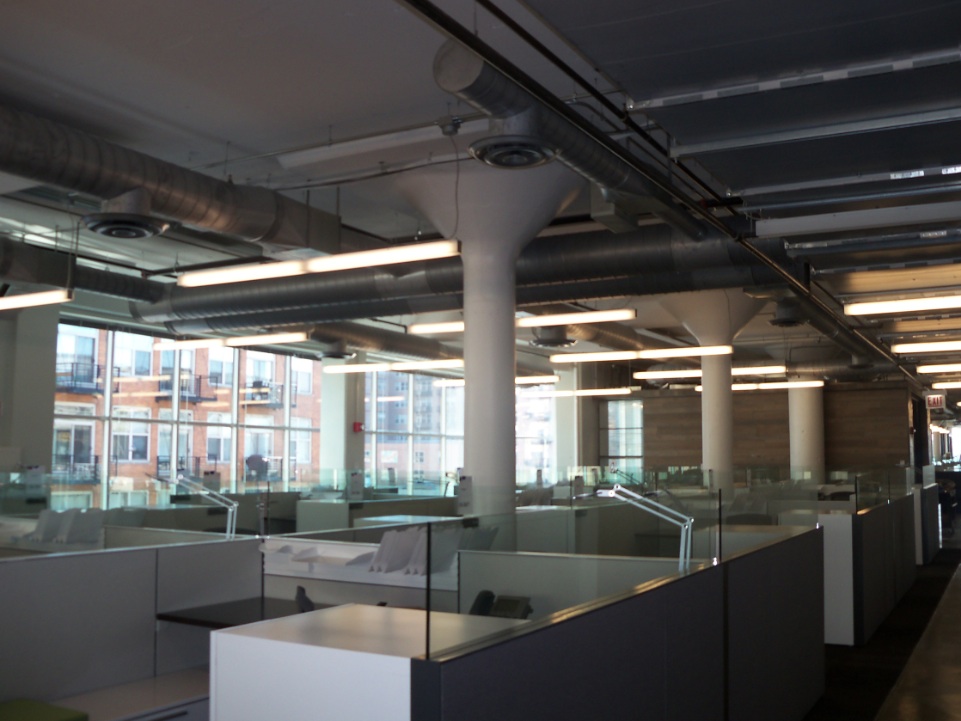When Sara Lee Corp. changed its name to Hillshire Brands and relocated from the suburbs to downtown Chicago in December 2012, the company gained a new lease on life.
Hillshire moved a portion of its corporate headquarters into the newly renovated, four-story 400 South Jefferson Street building in the city’s West Loop. Built in 1944 for the Newman-Rudolph Lithographing Co., the 230,000-sf structure was stripped down to its cast-in-place concrete frame and rebuilt with a modern glass curtain wall façade, new passenger elevators, major building system updates, and an indoor parking garage.
The $70 million, fast-track project—led by Proteus Group (architect, core and shell), Leopardo (general contractor, core and shell), Perkins+Will (architect, interior build-out), Clune (general contractor, interior build-out), Sterling Bay Cos. (owner/developer), Environmental Systems Design (MEP/FP), Project Management Advisors (project management), and Colliers (tenant representative)—was completed in just 10 months using a BIM/VDC/IPD workflow.
The core and shell team had the full 10 months to complete its portion of the project, but the interior build-out team had just four months. The interior work entailed four general office floors, three test kitchens, and a tower housing conference rooms.
Initially, the base building contractor modeled the as-built conditions using BIM, after which the interior design was added by Perkins+Will, before releasing the model to Environmental Systems Design. ESD had just four weeks to complete bid and permit documentation for the building’s MEP and fire protection systems.
5 Tips for collaborating with BIM
1. All consultants working in BIM should coordinate during architectural model development, rather than after completion of the architectural model. Communicating your expectations prevents coordination issues from occurring later in the project design. In the case of the Hillshire HQ project, the architects and engineers met before the BIM model was initiated to talk about past concerns and project design expectations.2. Set up trade drawing sheets at the start of the project. Designers often forget to set up trade drawing sheets and don’t think about them until the end of the project when they want to print. The absence of trade drawing sheets can hold up a project. As cool as the 3D model is, the 2D drawing is what everyone will use after the design has been completed.3. BIM programs are not CAD; don’t use them as if they were. Most AEC professionals learn how to design in 2D CAD, so when moving into BIM they try to replicate what is done in CAD, like drawing text boxes, without utilizing the “smarts” in BIM. In addition, understand that you’re working in a 3D environment and you need to pay attention to the “Z” axis, or the vertical plane. For the first time, height needs to be defined. How high are you mounting the ductwork or the light fixture? Those questions need to be answered early on.4. Use BIM to create ventilation schedules. Take advantage of the information already held in the model, such as the defined volume and ceiling height of each room. Let the BIM model fill out ventilation schedules and calculate air quantities of individual air terminals.5. Set up electrical equipment properties and panel schedules at the beginning. This speeds up circuiting in the end. Every time a piece of equipment is placed into the BIM model, fill in the information about the piece of equipment from the start so that schedules auto-populate at the end.— Amanda Carter
Could BIM really speed up design, eliminate coordination issues among the trades, and limit requests for information during construction? ESD set out to find the answer.
Beginning with Autodesk’s Revit MEP, ESD engineers created a 3D interactive model. Using Revit’s automatic scheduling feature, they simulated the building’s potential loads, including air quantities and electrical loads. Defining the space types and square footage of each room within the model allowed BIM to automatically calculate the ventilation requirements of the applicable mechanical codes for each space. These quantities were scheduled and allowed the mechanical engineers to assure that the proper amount of supply air would be provided to each room.
Similarly, by defining specific loads and demand factors for the electrical elements within the Revit model, the panel schedules were able to self-populate and properly calculate both the total connected and demand load for each piece of electrical equipment in the building. This allowed for proper sizing of over-current protection for each piece of equipment throughout the electrical distribution, as well as the associated feeders and conduit.
Because each of the schedules was based on the definition of elements within the model, they were able to self-populate and automatically update to changes, allowing for fewer coordination issues within the construction documents. The model also helped the team lay out the ductwork so that it coordinated with light fixture locations in the building’s open ceiling layout, and ensured that the design of the electrical equipment met the dimensions of the designated equipment areas.
Together, these elements produced a complete model of the building’s MEP infrastructure with much more certainty than the traditional 2D modeling, and did so within the tight time frame.
Unfortunately, however, BIM can’t read the human mind. When the base building contractor altered the layout of the large electrical rooms in the field, the project’s contractor couldn’t build out the space as designed by ESD, per the base building model. Switches and equipment were housed in different locations within the space, resulting in an RFI that required re-coordination.
After the contractor in the field proposed a couple of options for the final equipment layout and ESD submitted the redesign, the large electrical rooms were built within the desired time frame. Despite this challenge, using BIM to coordinate between trades on the front end still resulted in fewer RFIs and allowed the Building Team to meet the tight design and construction schedule, avoiding major discrepancies in the field.
Comparing 2D to 3D for Performance
As a comparison, ESD previously designed a similar project in 2D CAD. This second project employed the same lead engineers and interiors contractors, with similar square footage and a large commercial kitchen, and was designed and constructed as the base building was being completed. The result? The Hillshire headquarters had approximately half the RFIs of the 2D-designed project.
To further test the success of BIM in the field, ESD selected a few locations throughout the Hillshire headquarters where “snapshots” of the Revit model were compared to post-construction photos of the same space. In every case, side-by-side visual comparisons showed that the construction documents were almost identical to what was installed in the field. Considering the speed at which both design and construction were completed, it was amazing that the end result so closely matched the original design.
While BIM was used on the project primarily to coordinate between trades during design, in the end, it helped the entire Building Team meet a tight schedule, eliminate coordination problems between the trades, and limit RFIs in the field.
Amanda Carter, FE, is an Electrical Engineer and Associate at Environmental Systems Design, Chicago (www.esdesign.com). She can be reached at acarter@esdglobal.com.
Related Stories
| Sep 12, 2011
PVs play new roles as a teaching tool
Solar installations are helping K-12 schools around the country save money and teach students the intricacies of renewable energy sources.
| Sep 12, 2011
Living Buildings: Are AEC Firms up to the Challenge?
Modular Architecture > You’ve done a LEED Gold or two, maybe even a LEED Platinum. But are you and your firm ready to take on the Living Building Challenge? Think twice before you say yes.
| Sep 12, 2011
First phase of plan to revitalize Florida's Hialeah Park announced
This is the first project of a master plan developed to revive the historic racetrack.
| Sep 12, 2011
Geist opens European branch
The new branch provides the company’s international clients with additional support and services.
| Sep 9, 2011
$22 million investment made in energy efficient building maker
The buildings use at least 25% less energy than the strictest building codes in the U.S., and as much as 80% less energy in certain parts of the country.
| Sep 9, 2011
Hardinger joins Ryan Companies as vice president, mission critical
He will lead the Ryan team responsible for building and developing data centers and other mission-critical projects, and will oversee business development, client relationships, executive level communications and overall marketing strategies for the division.
| Sep 7, 2011
KSS Architects wins AIA NJ design award
The project was one of three to win the award in the category of Architectural/Non-Residential.
| Sep 6, 2011
Construction on Beijing's tallest building starts next week
The 108 floor mixed-use skyscraper consists of offices, apartments, hotels and shopping malls on the lower floors.
| Aug 24, 2011
Deadline Extended: 2012 "Best AEC Firms to Work For” Awards
We’re looking for firms that create truly positive workplaces for their AEC professionals and support staff. In other words, this awards program will recognize those AEC firms that nurture and develop their most valuable asset—their people.
| Aug 19, 2011
How and why AEC professionals choose flooring systems
Design and construction professionals who completed our flooring survey had strong opinions about their preferred flooring type.















